Introduction – Electricity Used By A Home
[Update 03/09/2024: we updated the average household electricity consumption figures using the latest data from EIA from 2023 which is current as of March 2024]
Do you know how much electricity your home uses per day, per month or per year? As of March 2024, in the United States, the average household uses 850 kWh of electricity per month, or 10,204 kWh of electricity per year. This means the average household uses 28 kWh of electricity every day. Below we present how we computed this and electricity use in other countries.
Average Electricity Consumption Per Year, Month and Day
Here we present the average consumption for year, month and day use. We use the US government’s EIA aggregate electricity reports for Mar 2024 to calculate the annual, monthly and daily figures. The EIA releases data every three months, annualized over the preceding See below for a description of the methods.
Average household electricity consumption per year is 10204 kWh (kilowatt hours).
Average electricity consumption per month is 850 kWh.
Average electricity consumption per day is 28 kWh.
These numbers are for a U.S. residential utility customer, which basically means a household or apartment unit.
Single Household – Instantaneous Usage
The power needs of a house at any instant then is on average 1.2 – 2.3 kilowatts.
[Update: aggregate figures are rolling updates and new as of Dec, 2023; Statistics for state figures haven’t been released and remain unchanged.]
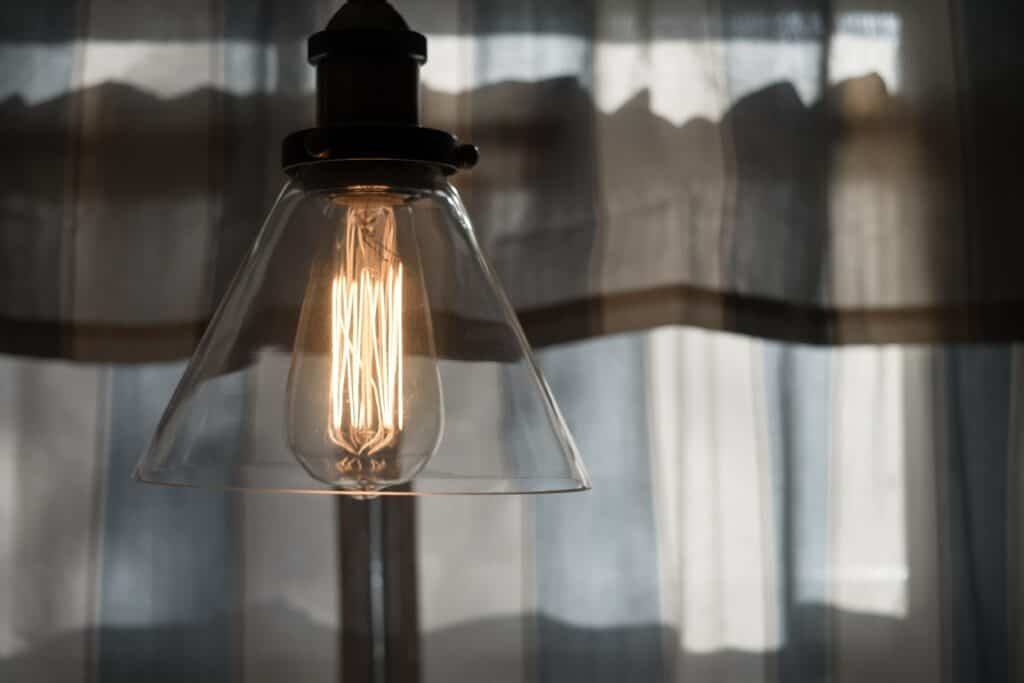
Summary Table For Average Household Electricity Use Per Day, Month And Year
Here is the average household electricity summarized into a table.
| Frequency | Average Household Usage (kWh = kilowatt hours) |
| Per Year | 10,204 kWh |
| Per Month | 850 kWh |
| Per Day | 28 kWh |
| Instantaneous | 1-3 kW (kilowatts) |
Notes On Calculations And Data Sources
To calculate the annual, monthly and daily figures, we used the aggregate electricity use by residential customers reported by the EIA on a rolling basis until Dec 2024 which was 1,454,667,000,000 kWh. We also used the total number of US residential units, which according to estimates using the latest census figures are 143,786,655.
To get the instantaneous usage, we note that the number of hours in a year is 365 times 24 = 8760 hours. Then on average, at any one time, your house is using 10,204 kWh divided by 8760 hours, which is 1.16 kilowatts. If most of the load is during the day, then we can approximate it to be double at 2.32 kilowatts.
Average Household Electricity Use By State, and Cost Per kWh
For each state, below are the average daily kWh, average monthly kWh and average annual kWh. We also provide the cost of electricity per kWh.
| State | Annual Usage per Household (kWh) | Monthly Usage per Household (kWh) | Daily Usage per Household (kWh) | Cost per kWh (Cents) | Average Monthly Bill ($) |
| Alabama | 14497 | 1208 | 40 | 13.1 | 158.25 |
| Alaska | 9047 | 754 | 25 | 22.2 | 167.39 |
| Arizona | 10231 | 853 | 28 | 12.57 | 107.22 |
| Arkansas | 13375 | 1115 | 37 | 11.35 | 126.55 |
| California | 5812 | 484 | 16 | 26.04 | 126.03 |
| Colorado | 8785 | 732 | 24 | 14.15 | 103.58 |
| Connecticut | 9493 | 791 | 26 | 23.42 | 185.25 |
| Delaware | 12051 | 1004 | 33 | 14.61 | 146.68 |
| District of Columbia | 7530 | 628 | 21 | 15.05 | 94.51 |
| East North Central | 10164 | 847 | 28 | 15.5 | 131.28 |
| East South Central | 14350 | 1196 | 39 | 12.65 | 151.29 |
| Florida | 11344 | 945 | 31 | 14.21 | 134.28 |
| Georgia | 13635 | 1136 | 37 | 11.76 | 133.59 |
| Hawaii | 6213 | 518 | 17 | 44.79 | 232.01 |
| Idaho | 15907 | 1326 | 44 | 10.47 | 138.83 |
| Illinois | 9171 | 764 | 25 | 15.98 | 122.09 |
| Indiana | 12947 | 1079 | 35 | 15.25 | 164.55 |
| Iowa | 12917 | 1076 | 35 | 11.25 | 121.05 |
| Kansas | 10899 | 908 | 30 | 13.24 | 120.22 |
| Kentucky | 14888 | 1241 | 41 | 13.05 | 161.95 |
| Louisiana | 13211 | 1101 | 36 | 12.5 | 137.62 |
| Maine | 7190 | 599 | 20 | 22.44 | 134.42 |
| Maryland | 13827 | 1152 | 38 | 15.53 | 178.91 |
| Massachusetts | 6795 | 566 | 19 | 30.64 | 173.42 |
| Michigan | 8301 | 692 | 23 | 17.91 | 123.94 |
| Middle Atlantic | 8811 | 734 | 24 | 19.29 | 141.59 |
| Minnesota | 10638 | 886 | 29 | 13.15 | 116.51 |
| Mississippi | 13153 | 1096 | 36 | 12.33 | 135.14 |
| Missouri | 14744 | 1229 | 40 | 10.54 | 129.54 |
| Montana | 14920 | 1243 | 41 | 11.77 | 146.3 |
| Mountain | 10358 | 863 | 28 | 12.57 | 108.48 |
| Nebraska | 14969 | 1247 | 41 | 9.7 | 120.96 |
| Nevada | 9134 | 761 | 25 | 14.96 | 113.85 |
| New England | 7655 | 638 | 21 | 26.96 | 172 |
| New Hampshire | 7781 | 648 | 21 | 30.88 | 200.1 |
| New Jersey | 7924 | 660 | 22 | 16.68 | 110.09 |
| New Mexico | 8357 | 696 | 23 | 13.34 | 92.85 |
| New York | 6876 | 573 | 19 | 22.78 | 130.53 |
| North Carolina | 14543 | 1212 | 40 | 11.48 | 139.14 |
| North Dakota | 19193 | 1599 | 53 | 9.63 | 153.98 |
| Ohio | 11704 | 975 | 32 | 13.97 | 136.21 |
| Oklahoma | 13741 | 1145 | 38 | 11.11 | 127.21 |
| Oregon | 15145 | 1262 | 41 | 11.13 | 140.46 |
| Pacific Contiguous | 8545 | 712 | 23 | 18.18 | 129.44 |
| Pacific Noncontiguous | 7349 | 612 | 20 | 33.63 | 205.82 |
| Pennsylvania | 11997 | 1000 | 33 | 17.77 | 177.7 |
| Rhode Island | 7205 | 600 | 20 | 27.52 | 165.12 |
| South Atlantic | 13333 | 1111 | 37 | 13.3 | 147.76 |
| South Carolina | 13606 | 1134 | 37 | 13.86 | 157.17 |
| South Dakota | 15610 | 1301 | 43 | 11.22 | 145.97 |
| Tennessee | 14411 | 1201 | 39 | 12.16 | 146.04 |
| Texas | 12481 | 1040 | 34 | 14.49 | 150.7 |
| U.S. Total | 11144 | 929 | 31 | 14.94 | 138.79 |
| Utah | 9718 | 810 | 27 | 10.47 | 84.81 |
| Vermont | 7910 | 659 | 22 | 19.94 | 131.4 |
| Virginia | 16007 | 1334 | 44 | 13.81 | 184.23 |
| Washington | 16410 | 1368 | 45 | 10.04 | 137.35 |
| West North Central | 13132 | 1094 | 36 | 11.39 | 124.61 |
| West South Central | 12778 | 1065 | 35 | 13.58 | 144.63 |
| West Virginia | 17593 | 1466 | 48 | 12.75 | 186.92 |
| Wisconsin | 9327 | 777 | 26 | 15.01 | 116.63 |
| Wyoming | 14600 | 1217 | 40 | 10.38 | 126.32 |
Observations Of Average Household Electricity Use By State
Variation in Usage: There’s a significant variation in the annual electricity usage per household across different states. States like West Virginia and Alabama have high annual usage (around 17,593 kWh and 14,497 kWh respectively), while California has a notably lower annual usage (approximately 5,812 kWh). This variation is due to differences in climate, average household size, energy efficiency measures, and types of heating and cooling systems used.
Electricity Cost and Monthly Bill: The cost per kWh also varies widely among states, which affects the average monthly electricity bill. Despite having lower electricity usage, California’s higher cost per kWh results in an average monthly bill (approximately $126.03) that is comparable to states with higher usage but lower costs. Conversely, states like Alaska, despite lower usage rates, have higher average monthly bills due to the high cost per kWh.
Regional Differences: The data also shows regional differences, with states in colder climates or with less access to alternative energy sources tending to have higher usage and/or costs. Similarly, regions with a focus on green energy and energy efficiency measures may have lower usage rates.
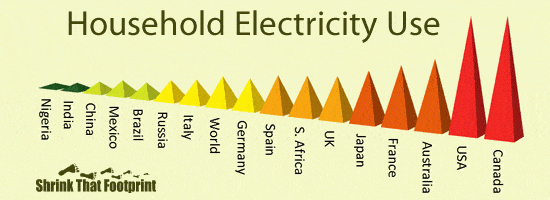
Average Household Electricity Use Around The World – 2023
About 90% of people in the world have access to electricity. This figure increased from 2010-2020 but then dropped since the COVID pandemic. But despite the fact more people are getting access to electricity we use very different amounts of it.
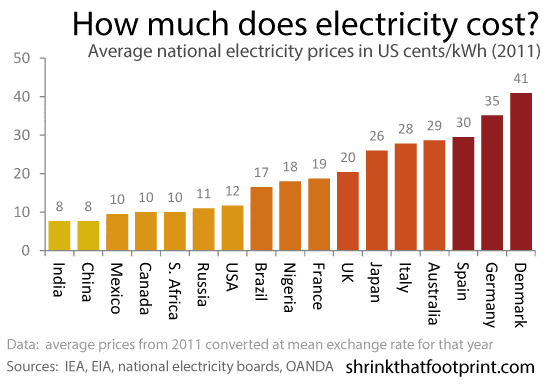
Using data from the World Energy Council we can compare how much electricity the average electrified household uses in different countries.
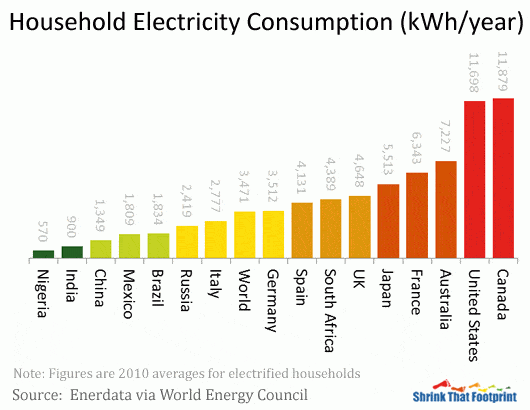
We also present data from IEA.org updated for 2023. This is in tabular form instead of a chart so you can copy and paste it. Note we’ve ordered it as the chart so its ranked in “kWh per household”. What should stand out is that the numbers haven’t moved too much. Canada and United States really stand out. We included also the number of households. You can see that Sweden is a much smaller country but uses more electricity than Australia or France which are larger. Notably Sweden’s electricity is very low in carbon because of hydro and nuclear.
| Country | Number of households | kWh per Household (annual) |
| Canada | 15,618,491 | 11,305 |
| US | 132,736,055 | 11,156 |
| Sweden | 4,776,239 | 8,914 |
| New Zealand | 1,906,474 | 6,754 |
| Australia | 10,220,186 | 5,919 |
| France | 30,217,950 | 5,344 |
| Hong Kong | 2,646,107 | 4,900 |
| Ireland | 1,799,221 | 4,857 |
| Japan | 55,704,949 | 4,749 |
| Malaysia | 7,176,812 | 4,456 |
| Spain | 17,565,288 | 4,169 |
| UK | 29,486,179 | 3,658 |
| Netherlands | 7,874,258 | 3,130 |
| Germany | 40,624,971 | 3,127 |
| Russia | 56,771,478 | 2,879 |
| Italy | 25,020,120 | 2,646 |
| South Africa | 17,733,119 | 2,614 |
| China | 522,689,264 | 2,180 |
| Indonesia | 69,855,344 | 1,720 |
| Philippines | 25,893,157 | 1,324 |
| India | 299,727,860 | 1,005 |
Across the countries we chose to compare household electricity use varies enormously. The average American or Canadian household in 2010 used about twenty times more than the typical Nigerian household, and two to three times more than a typical European home.
Comparing The US, France, UK and China
In the US typical household power consumption is about 10,178 kWh each year, in France it is 6,400 kWh, in the UK it is 4,600 kWh and in China around 1,300 kWh. The global average electricity consumption for households with electricity was roughly 3,500 kWh in 2010.
There are numerous things that drive these differences, including wealth, physical house size, appliance standards, electricity prices and access to alternative cooking, heating and cooling fuels.
Factors That Explain Why Consumption In China Is Low And India Is Even Lower
Perhaps the most surprising thing in this chart is that the global average is as high as 3,500 kWh/year, given that the figures for India and China are so low. Two things explain this, household size and electrification rates.
In China about 99% of people have electricity and average household size is around 3. In India these are 66% and 5 respectively and in Nigeria 50% and 5. Average household size in most wealthy countries is closer to 2.5 people. As a result the distribution of electrified households is more skewed towards wealthy countries than population in general.
Global Home Electricity Use Per Person
By taking residential electricity use and dividing it by population we can look at how much electricity the average person uses at home in each country. Unlike in our previous graph this chart takes in to account all the people in each country, so for places where electricity access is not universal the figures are lower.
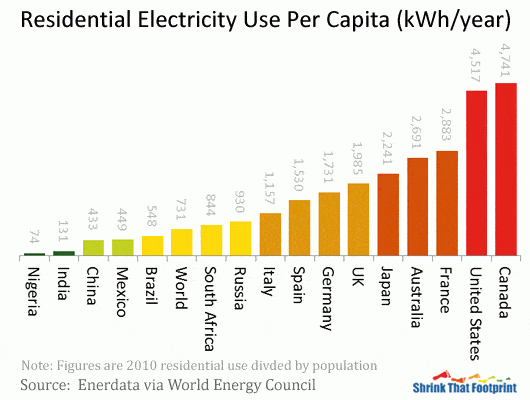
Although the graphs look very similar there are some striking differences.
Americans Use 5X More Power Than Global Average
Each American uses about 4,500 kWh per year in their home. This is about six times that of the global average per capita, or more than five times the average for those who have electricity access.
The variation between developed countries is also quite stark. While the US and Canada are up around 4,500 kWh per person the UK and Germany are below 2,000 kWh. In Brazil, Mexico and China per person use is just 500 kWh, but growth is very different. In Brazil residential use per person has been stable over the last 20 years, whereas in Mexico it is up 50% and in China it has increased 600%.
Where Is Yours Like?
Our household electricity use has been 2,000 kWh each of the last few years, which means it is about 700 kWh per person. We benefit from not using electricity for heating or cooling, although our electric oven is a big source of demand.
That makes us a Brazilian family, but global people 😉
How do you stack up?
Data Sources
Instructions:
For the average household electricity use across the US we use the rolling updated 12 months electricity use published by the EIA, which means the data is very fresh, only about 3 months behind. Therefore, if its July right now, the data shows the 12 month electricity consumption up until Apr only 3 months ago. This is a change in our methodology as before we had used annual published figures. Specifically we’re using Table 5_01 here. If the link has changed, then navigate to the data page and go to “Sales” and navigate the menu as below. The last item contains two links, XLS and Interactive that lead to rolling 12 month electricity use.
- Retail sales of electricity to ultimate customers
- Monthly
- Monthly Release date: Dec 27, 2023|Data from:Electric Power Monthly
- By sector
- Available formats: XLS|Interactive
Old data came from the EPA data store on residential electricity provider using these files collected annually.
For the average household electricity use in each state, we use the annual electricity sales by state compiled by the EIA. There are year-to-date figures by state, annual figures and monthly figures but no rolling annual figures so these are updated less frequently.
Lindsay Wilson
I founded Shrink That Footprint in November 2012, after a long period of research. For many years I have calculated, studied and worked with carbon footprints, and Shrink That Footprint is that interest come to life.
I have an Economics degree from UCL, have previously worked as an energy efficiency analyst at BNEF and continue to work as a strategy consultant at Maneas. I have consulted to numerous clients in energy and finance, as well as the World Economic Forum.
When I’m not crunching carbon footprints you’ll often find me helping my two year old son tend to the tomatoes, salad and peppers growing in our upcycled greenhouse.

Hello Lindsay,
I read your information to confirm data about energy usage around the world. Thanks for all your research on energy. You may be interested on my company and my invention, patented and prototype only 10% fuel used. I have problems with marketing due to my small town in West Virginia. I am looking for partners to bring my invention to stop 80% to 90% waste with today method.
Here my presentation link. https://docs.google.com/presentation/d/1b-E_dj37yqyfmg26t9y_wSaxNtdBmLkolo6vIscvgrY/edit?usp=sharing
These generalized electricity use comparisons are becoming less and less relevant as time goes on. Why? Electric heat pumps, used for both water and space heating, and EVs. For example, we used 9,500 kWh in 2023. Of that total, 3,236 kWh(34%) was used to charge two EVs and 2,047 kWh(22%) was used for electric HP space heating. Subtract those two and you’re left with 4,217 kWh, or 44% of total use! Location- lower Midwest USA. Home- 200 square meter with two occupants. Kids have grown and moved out. 2023 wasn’t that cold here with a low of 17F(-8C) and a high of 100F(38C).